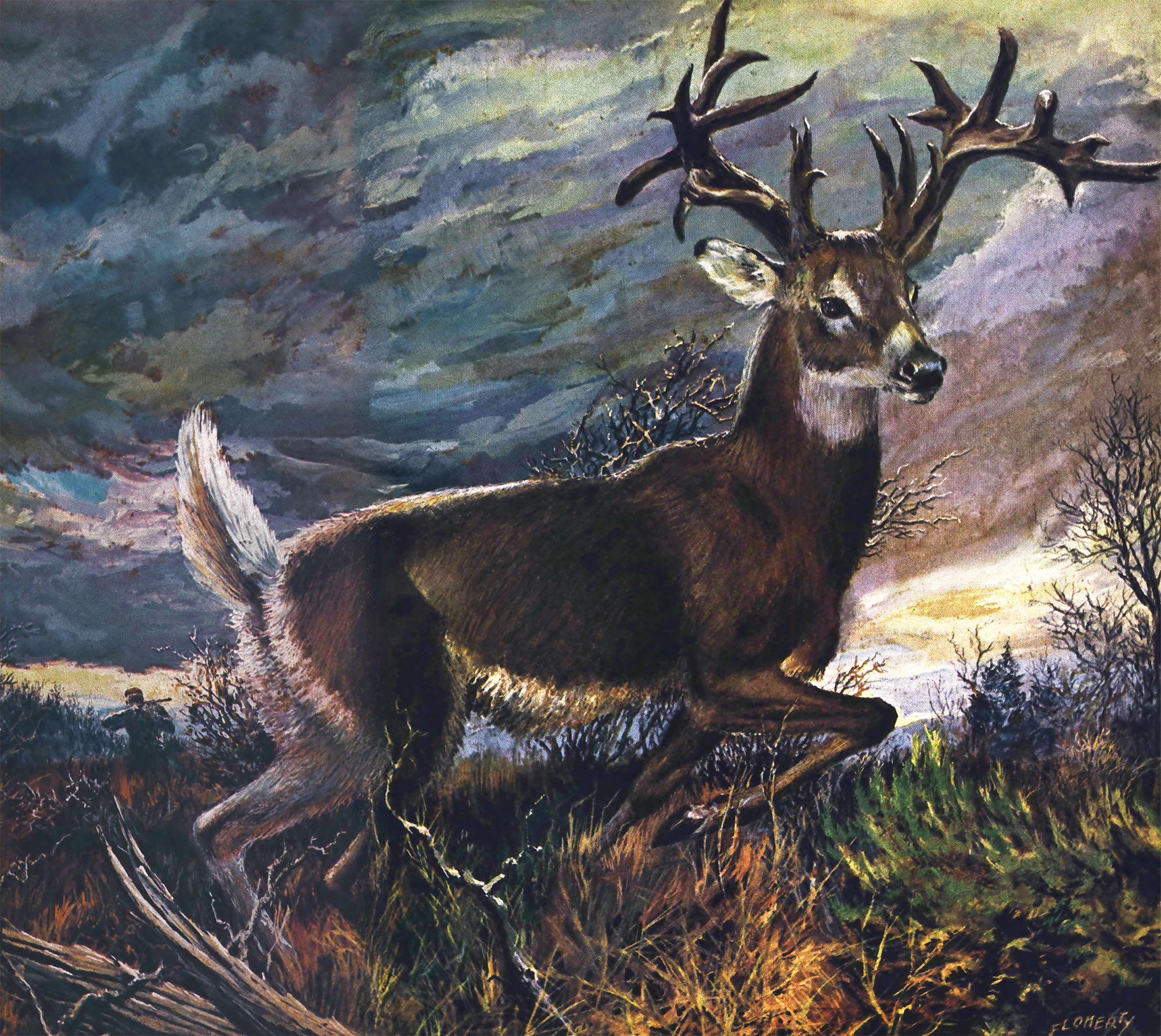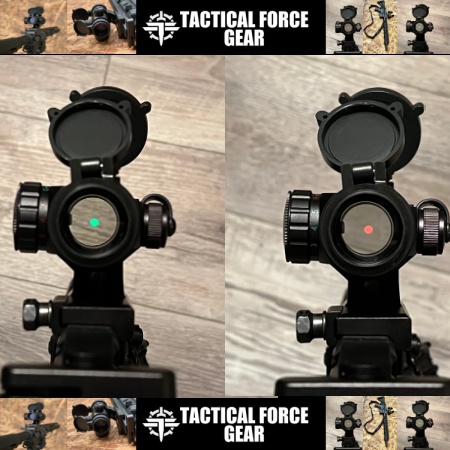This story, “The ‘Legend’ of Buck Hollow,” appeared in the January 1973 issue of Outdoor Life. Veach’s buck is still one of the largest deer ever killed in Ohio, and is listed at No. 5 for the state (and No. 51 of all time) by Boone and Crockett.
There’s a place in the hill country of southern Ohio, not far from the town of Beaver, that the local farmers have called Buck Hollow for as long as anybody can remember. For my money, it’s well named.
The hollow is about three miles long and less than half as wide. A stream winds down the middle of it, running into the Scioto River, and also running through is a road, macadam as far as the George Wollum place, gravel the rest of the way.
A dozen or more smaller side hollows fork off like the branches of a tree. They run up against the steep ridges that flank the main hollow on both sides. The whole place is timbered, but there are scattered farms down on the bottomlands.
Many years ago some farmer had a corn patch about halfway up one of the side coves. That little field is growing up with brush now, but it is still more open than the low ridges on either side. An old wagon road, also unused and brush-grown, angles down from the head of the cove and threads across the abandoned cornfield.
I’ll remember that spot as long as I live. It was there, on a cold gray morning in late November 1971, the second day of the Ohio deer season, that I killed the best nontypical whitetail ever taken in that state — a buck that stands in fourth place on the Boone and Crockett Club’s all-time record list.
I’m anything but an experienced deer hunter. In fact, that was my first deer hunt, and I still have trouble believing, my beginner’s luck.
I grew up near Vanceburg on the Ohio River in northeastern Kentucky. I was born in 1916, and deer were so scarce in that area when I was a kid that the sight of one was something we talked about for weeks. There was no open season on them. But there was small game to hunt — squirrels, quail, and rabbits — and I began hunting as soon as I was big enough to lug a gun.
In 1935 I moved to Ohio, and in 1940 I opened a gas station in Columbus where my wife Garnet and I still live. So far as I can remember, there was no deer season in Ohio then, and when one finally opened I was too tied down by the gas-station business to take advantage of it.
I did take a day off and then to hunt gamebirds — pheasants were my first love, and Southern Ohio had some good pheasant hunting — but trying for deer meant three or four days at a time, and that was more than I could spare. Quite a few of my friends and the members of my family went to Penn:-.ylvania or Michigan for deer every fall. but that called for even more time off.
In June of 1971 I sold the station: I wanted no more of the seven-day-a-week schedule. Garnet had held a real-estate broker’s license for several years, and I went to work with her. When fall came I’d be able to take as much time as I wanted for hunting, deer included. Our two children, a son 24 and a daughter 20, were away from home. My wife and I agreed that we’d slow down and do the things we wanted.
I began to make my deer-hunting plans in early fall. There’d be four in our party: my brother Clarence and Charlie Miles, both of Columbus; Ralph Swickard from the suburb of Westerville; and me.
I was the only rookie in the group. The three others had hunted deer every fall for 15 or 20 years, in Pennsylvania, Michigan, Canada, and Ohio.
The place we picked for our hunt was Buck Hollow. Lying at the eastern edge of Pike County, within the boundaries of the Wayne National Forest, it’s about as good deer country as any in Ohio. A paper company at Chillicothe owns a big tract of timber in that area and has carried on logging operations for years. The cutover land has grown up to brush, and enough small farms are scattered through the hollows to supply corn and soybeans. Plenty of corn goes unpicked all through the fall. Deer grow big and fat in such range as that.
We had a couple of other reasons for choosing the hollow. We knew that an exceptional whitetail buck lived there. Quite a few people had seen him, including my wife’s nephew, Max Bapst. Max is a logger who does a lot of hunting and trapping, and it was he who had told me about the big deer. His rack was the best Max had ever seen, and other people who had caught glimpses of the buck — including one or two hunters who had shot at him without doing any damage — agreed. That buck, my partners and I decided, was a deer worth trying for.
The final reason for our choice of Buck Hollow was that I’d be in familiar territory. George Wollum is my brother- in-law, and his farm, at the end of the blacktop road, is where my wife grew up. I had spent plenty of time in that neighborhood.
The deer season would open on Monday, November 29. The four of us drove down to Wollum’s place on Sunday afternoon and spent the night there. At daylight a drizzle was falling, and it kept coming down all day long.
We went out anyway, hunting the lower end of the hollow below the farm. In all my year in the woods I had never seen deer sign more plentiful. There were runways, fresh tracks in the wet ground, beds, and rubbed and broken brush on which bucks had polished their antlers. But nobody in the party scored that morning.
At noon we came in to eat lunch and dry out. We went back to the woods in midafternoon. Our luck was no better. And when we quit, shortly before dark, nobody had seen so much as a white flag. But one thing \·as clear: ‘”‘e had picked a place with a healthy deer population. And we had heard quite a lot of , hooting. Apparently other hunters were having better luck than we were. Our hopes for the second day were high.
When we rolled out on Tuesday morning the rain had stopped although the sky was still overcast, and the weather had turned cold. The day would be almost ideal for hunting, with the woods and ground wet enough to muffle sound. We decided to hunt the part of the hollow above the farm.
We left the house right after breakfast. and half a mile up the road we separated in order to hunt two of the small branch hollows. Ralph Swickard and I took one: Clarence and Charlie Miles took the second. which ran parallel to ours, over a low ridge to our left. Both of these narrow coves ended against the main ridge. We agreed to meet there about noon.
Deer sign was as plentiful as it had been the day before. Beds, tracks, pawed-up ground where deer had searched for acorns, and rubbed brush kept me worked up. Ralph was following an old logging road, long unused, that wound up the middle of the hollow. I was keeping to the ridge 300 yards to his right. That way, if either of us jumped a deer, there was a good chance it would cross in front of the other.
I moved very slowly and quietly, walking a few steps, stopping to listen and look, then repeating the sequence. A couple of times I heard shots in the distance, on the main ridge and to my right. None of our party was hunting in that direction. Other hunters probably were having luck.
I found a place where deer had been feeding on acorns. Patches of wet leaves were overturned. and the sign looked very fresh. My blood pressure started to go up. I took a couple of careful steps, a finger on the safety of my gun, and out of a thick tangle of vines almost beside me a ruffed grouse roared up ·with a thunder of wings.
I must have jumped 10 feet to the side. A flushing grouse is likely to do that to me, and making the flush more nerve-shattering was the fact that I was expecting a deer to go crashing out. I had still-hunted for about two hours when the ridge I was following got too rough and brushy for me. I dropped down to the bottom of the hollow and came out just above an abandoned farm. I had stopped at the edge of an opening for a careful look ahead when three quick shots rapped out over on my left. where Clarence and Charlie Miles ought to be. I started to move that way, to find out what had happened.
It turned out that Miles had jumped two deer in very thick stuff. A doe broke out ahead, and he had a good look at her. Then a buck flashed into sight, following her, and Charlie said afterward that in all his years of deer hunting he had never seen anything like that rack.
The deer was beyond good shotgun range before it came in sight, but Charlie sent three long shots in its direction in the hope of pushing it in front of one of his partners. Those were the shots I’d heard.
“Man, I hope somebody kills that buck,” Charlie told Clarence. “No one will ever believe my story about his antlers unless they see him.”
Nothing happened for five or 10 minutes after that. I worked very slowly up the cove, stopping every few yards to listen. I carne to the old brush-grown corn patch that I described in the beginning, and when I was halfway across it a shotgun thudded out two flat reports in quick succession, at the head of the cove a quarter-mile above me.
I stopped and waited. I knew enough about deer hunting to realize that if enough hunters are in the woods to keep deer moving, the wiliest whitetail in the county, fleeing from danger behind him, might blunder into a hunter head-on.
There was a pause that lasted maybe three or four minutes but seemed much longer; the wet woods stayed silent except for the low sound of wind in the trees. Then I heard a deer coming.
The footfalls were about 200 yards off, and the deer was headed straight for me. From the noise it was making I started to thump, and I suppose my eyes got as big as saucers. Nothing like that had ever happened to me before.
What came next is still hard to believe. I saw a big rack of antlers dodging downhill in my direction through briers and thick brush. I couldn’t see hide or hair of the deer under that rack, even when he cleared low obstacles. The antlers seemed to be running by themselves in long, reaching bounds.
I have read stories of moose hunters who saw moose racks that floated above thick willows as the animal walked or trotted. These deer antlers didn’t float. Rather they rose and dropped and twisted and turned. The deer was keeping mostly to the old wagon road because the cover on either side was very dense. But even in the road there was too much brush for me to get a glimpse of anything but his rack.
Those antlers ran at me for at least 100 yards — in plain sight but seemingly attached to nothing. It was the spookiest and most exciting thing that had ever happened to me.
Ohio regulations limit deer hunters to the use of shotguns with slug loads. I was carrying a Winchester Model 1200 pump gun in 20 gauge.
I brought it up no and held the sight on that disembodied rack, waiting for the deer to cross an open place and show himself. The situation would have shaken the most experienced deer hunter. For me it was almost more than I could endure.
I can’t remember how close the buck was when he finally broke clear of brush .. I do know that if he had not changed course he’d have raced past on my left, no more than 15 yards away.
I was standing beside a thicket but not hidden, and he saw me at the same instant I saw him. He slewed around broadside and kept running, flag up, rack held high, going for thick cover.
I held on his shoulder and drove my shot at him. He did not flinch or stagger. and his flag didn’t drop. I still don’t know whether I’d hit him.
He had time to make about two more jumps before I got off another shot. That time he plunged out of sight, and I was sure I had knocked him down. As it turned out, he ran down into the almost dry bed of a small strean-1 that had banks just high enough to hide him.
When I saw him again he was racing up the far bank, and I had a fairly clear shot the third time. That one belted him off his feet, and he stayed down. (We stepped off the distance later; the buck had dropped 82 paces from where I fired the last shot.)
I ran over, but the buck was dead when I got there. I had hit him twice. One slug had broken a shoulder; the other had gone in between two ribs, plowed through the lungs, and lodged against a rib on the far side. I still do not know which two of my three shots they were, but either one would have killed him quickly.
I stood there staring down at my first deer. The rack was a fantastic thing, too big to believe, and my first thought was This can’t be mine — not a deer like this!
I didn’t quite know what to do next. I had never field-dressed a deer and wasn’t sure how to begin. I was putting my tag on him when I heard another hunter coming, and then I saw a red cap over the brush. I assumed it was S:vickard, and I shouted to him, but it turned out to be a stranger.
He was from Cincinnati, he told me, and he had been hunting on the main ridge with a party that Max Bapst had taken out. He introduced himself, but in my excitement I forgot his name as soon as he told it.
“I got separated from my partners,” he said, “and I was up at the head of this hollow watching a runway when I heard something crashing through the brush behind me. I turned around and got a pretty good look at the biggest set of buck horns I ever laid eyes on. He rattled me so much I couldn’t get my safety off. When he was all but out of sight in the brush I shot twice, and I suppose I turned him downhill to you.”
The man stayed and chatted while I waited for Ralph Swickard, but Ralph didn’t come. Finally I decided to leave the deer and hike down to the Wollum place for help. Very few hunters were in the area, and I had killed the buck in a spot so isolated that I wouldn’t worry about anybody finding him and trying to make off with him. I wouldn’t be gone that long.
The Cincinnati man decided to go with me and wait on the road for his party to come out of the woods. We were about halfway back to the farm when we met Ralph, and I told him what had happened.
He told me to go on and get George Wollum and his pickup truck. He’d go back to the deer and dress it out. I described the place where I had killed it, and he headed that way.
George and I were able to drive his light truck to an old deserted farm about a quarter-mile from. the buck. There were three of us to do the dragging, but it was a tough chore. We never weighed my deer, but he was a big, thickset animal, fat and in prime condition. We guessed him at not less than 250 pounds field-dressed, and by the time Ralph and George and I got him down to the pickup we were ready to double that estimate.
I still didn’t realize what an extraordinary trophy I had taken. We got back to the farm with the deer around noon. My brother Clarence and Charlie Miles showed up shortly after we arrived, and when Charlie saw us grouped around the truck he let out a whoop.
“I bet they killed that big buck I jumped,” he told Clarence. ”Man, I hope so. If they did, they’ve got the biggest rack of deer horns in Ohio!”
He was to be proven right.
Any hunting after my kill was sort of an anticlimax. Even so, my three partners went out again after lunch, and I went along, leaving my gun at the house. If they killed a deer, I could help get it out of the woods. But no one in the party got a shot.
Two or three hours after dark that night we tied my buck on the back of our car and headed for home. By that time word of my kill had spread in amazing fashion. Before we’d eaten supper 20 to 30 hunters had gathered in the yard to examine and marvel at the rack. and from then until we left for Columbus around 9 p.m. a steady stream of strangers arrived at the Wollum farm. I had never realized that an unusual deer could bring a man such instant fame. That evening, after we left the state checking station at Beaver, we were stopped on the road by other hunters who had heard about the big buck and wanted to get a look at him.
Max Bapst had hunted in Buck Hollow the previous fall with Norman Meyer, a Cincinnati taxidermist, and they had talked about the big deer. Meyer had been impressed enough to make an offer.
”Tell you what I’ll do,” he had told Max. “I’ll mount free of charge the biggest deer anybody kills in this neighborhood next season. Just let me know who takes it, and I’ll get in touch with him. He just might have the deer you’ve been telling me about.”
Max passed the word of my kill along to Meyer, who came to see me. The outcome was that I turned the head over to him for mounting.
It was Meyer who alerted me to the fact that I had almost certainly taken a record-book buck. When the required 60- day drying period had elapsed, Merrill Gilfillan. a retired employe of the Ohio Division of Wildlife and an official Boone and Crockett Club measurer, taped the rack. It scored 261 5/8, high enough to rate fourth place in the club’s record list. It was also the best nontypical whitetail head ever entered from Ohio.
Read Next: The Biggest Nontypical Whitetails of All Time
The top three nontypical bucks in the Boone and Crockett records, according to the 1971 edition of “North American Big Game,” are a deer killed in Texas in 1892, score 286; a 1962 kill from Nebraska that scored 277 3/8 (the story of that one was told in “A Five-Year Stalk,” Outdoor Life, August 1963); a rack picked up in 1925, also in Texas, score 272.
For a hunter on his first deer hunt, I could hardly have asked for more. Don’t tell me there’s no such thing as beginner’s luck.
Read the full article here




